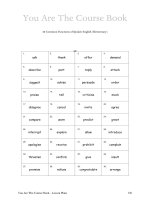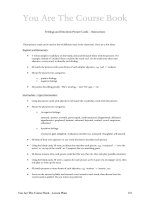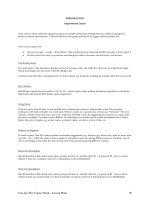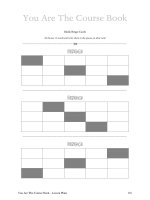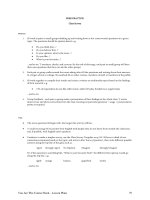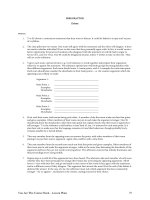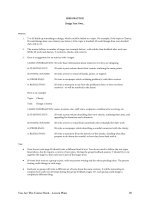yatcb lesson plans design your own
Bạn đang xem bản rút gọn của tài liệu. Xem và tải ngay bản đầy đủ của tài liệu tại đây (47.16 KB, 2 trang )
FREE PRACTICE
Design Your Own...
Method:
1.
T or SS think up something to design, which could be linked to a topic. For example, if the topic is Charity,
SS could design their own charity (see below); if the topic is Football, SS could design their own football
club, and so on.
2.
The session follows a number of stages (see example below), with whole class feedback after each one.
While SS work and discuss, T monitors, checks, and corrects.
3.
Here is a suggestion for an activity with 5 stages:
i) BASIC INFORMATION: SS write basic information about whatever it is they are designing
ii) STARTING OUT:
SS write a press release about their venture outlining the main points
iii) INITIAL SUCCESS:
SS write a letter or email of thanks, praise, or support
iv) PROBLEM(S):
SS write a newspaper article outlining problem(s) with their venture
v) RESOLUTION:
SS write a statement to say how the problem(s) have or have not been
resolved – or will be resolved in the future
Here is an example:
Topic:
Charity
Task:
Design a charity
i) BASIC INFORMATION: name, location, size, staff, aims, recipients, conditions for receiving, etc.
ii) STARTING OUT:
SS write a press release describing their new charity, outlining their aims, and
appealing for donations and volunteers
iii) INITIAL SUCCESS:
SS write a letter or email from somebody who is thankful for their work
iv) PROBLEM(S):
SS write a newspaper article describing a scandal connected with the charity
v) RESOLUTION:
SS write a statement from the director of the charity, detailing what they
propose to do about the scandal, or how they have dealt with it
Tips:
•
Note that at each stage SS should write a different kind of text. You do not need to follow the text types
listed above, but do require a variety of text types. During the group feedback session, T should try to tie
together the stages so that each text is part of the larger story.
•
SS write their texts as a group or pair, with one person writing and the others pitching ideas. The person
writing could change at each stage.
•
Each pair or group will write a different set of texts about the same venture. It will be interesting to
compare how each one develops during the group feedback stages. Or, each group could design a
completely different thing.
You Are The Course Book – Lesson Plans
89
•
A suggestion: each text must be no more than 4 sentences long, to keep the activity moving along fairly
quickly and to make it more manageable, although T could specify more or fewer sentences, depending on
the time they have.
•
Indeed, this is a flexible activity. The number of stages and the length of each one depends on how much
time T wants to fill and how quickly SS complete each text – as well as how long T specifies the text to be.
T needs to monitor the time closely so that SS get through the requisite number of stages. A quick rule of
thumb might be 10 minutes for each stage, including group feedback afterwards, which would make the
above activity with 5 stages last for around 50 minutes.
•
Project work like this is a good way for SS to get to know one another better, and is therefore an ideal
activity to do early on in a course.
You Are The Course Book – Lesson Plans
90
